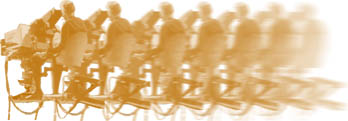From the Radio Times 1946.

| In the early days of AP we would sometimes do a "Local OB" from
our garden in the grounds of Alexandra Palace. It was about 500yards from the
building, and we fed a camera cable from racks, through a duct under the road
to the garden. We rigged one emitron camera, mounted on a tripod set on a
three-wheeled wooden dolly, and we would take all morning to get rigged,
ested and lined up. We would go "live" on air at three o’clock, without a
rehearsal, but this was no problem because the programmes were very simple,
with just a presenter talking to camera, with demonstrations, and the director
would talk us through the action. I was the cameraman on one occasion, and I lined up a head and shoulders shot of the presenter, who was standing in front of a demonstration table. The opening music faded, and I heard over my "cans" the continuity announcer, Winnifred Shotter introducing our programme. "Cue Bill" said the director, and we were off. " This afternoon I’m going to show you how to hive wild bees" (just the sort of thing your average viewing gardener needs to know!). Bill Gamblin continued, "First of all you must put on fully protective clothing". He then proceeded to put on protective coat, headgear, veil and gloves. Then he reached under the table, saying, " I have here a skep of wild bees". He promptly turned over the basket of bees onto the table. In an instant 10,000 bees were swarming round and about us. I could feel them crawling about on my focusing hand and bare arm. I pushed my face closer into the viewfinder visor to prevent any bees getting in there! I was only some six feet away from the angry swarm and felt somewhat uncomfortable. "First of all you must identify the queen bee," said Bill. "I’ve marked her with a spot, and you can see her here". "In you go," said the director over my cans. In we went – close up of queen bee at limit of focus – about 18 inches away, my viewfinder showing a mass of bees, with a big bee with a yellow spot marked on its back in the middle. The noisy humming was now intense, and I could feel the wretched bees everywhere on me, hands, and arms and back of head. After some further talk from Bill I thought that we had seen enough of the queen, and I signalled to Ronnie Koplick, my tracker that day, to pull back. No response to my finger. Frantic movement of finger – but still we do not move. In desperation I pulled my head out of the viewfinder to see what the problem was. No Ronnie to be seen behind the dolly but there he was on the far side of the garden by the fence, with the floor manager and make-up girl, sheltering from the bees! Well I guess we got through the programme somehow, without anyone being stung. When we had finished and were packing up "Sutt" (Mr Henry Sutton – SME), came down to see that all was OK. He hadn’t been in the garden for more than a minute, when a bee came zooming onto his forehead, and stung him – our only casualty! Of course nothing like this could happen these days with "Health and Safety at Work", but I can vouch for the truth of the above reminiscence, those many years ago. A suggestion that John has accidently switched some names around from Gordon Waters - " The SME referred to was Mr Leslie Sutton , the other SME on that shift was Mr Henry Whiting" . Thanks Gordon. |
| ...and this is how it must have looked, apart from the bees. From the Radio Times 1946. |
 |
|
 |